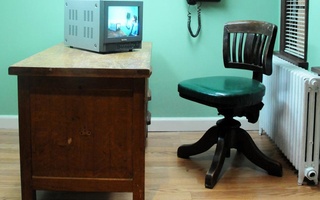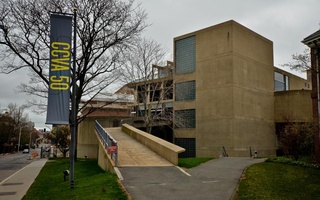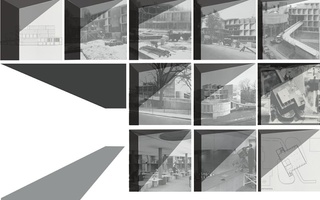"This picture often leads women to exclaim, 'Give me a kitchen like that!'" boomed Australian voice artist Bob Kuhn to a crowd wearing 3D glasses and intently gazing at the stereoscopic slide projection before them in the Carpenter Center’s Main Gallery. The image was of the futuristic, all-white kitchen in architect Walter Gropius's house in Lincoln, Massachusetts, and it was only one of the 20-or-so 3D images of Gropius House that the audience was fortunate enough to be able to view that evening.
During archival research for their Carpenter Center exhibition “Brute,” which is on view through April 7, artists and visual and environmental studies faculty members Katarina Burin and Amie Siegel found a mysterious box containing these stereoscopic slides and accompanying captions and decided to bring them back to life as a slide presentation. As the legacy of architect Le Corbusier and the history of Carpenter Center came under the spotlight with "Brute," which celebrates the 50th anniversary of the Carpenter Center, so in this event did the other great names associated with the building—among them Gropius, a founder of the Bauhaus School of architecture.
To contextualize the photographs, VES professor Laura Frahm gave a mini-talk before the slide performance. The talk explored the web connecting the building, Gropius, visual arts education at Harvard, the Bauhaus ideals, and another exhibition put on in the Carpenter Center more than 45 years ago: "Bauhaus––A Teaching Idea."
According to Frahm, the ’50s were a key moment for the visual arts' rise to prominence at Harvard. Through the 1956 Brown report, the Committee on the Visual Arts proposed a $6.5 million expansion in the visual arts program. The Committee wrote in a 1956 Crimson article, “Perhaps at no moment in history since the invention of printing has man's communication with his fellow man been so largely taken over by visual media as today.” The Committee was successful, and the Carpenter Center, the only Le Corbusier building in North America, was erected in 1963.
A couple of years later, in 1966, as work was underway to revamp the visual arts curriculum at Harvard, architectural historian Eduard F. Sekler organized the exhibition "Bauhaus––A Teaching Idea.” Through this exhibition, Sekler also articulated his Bauhaus-inspired academic agenda for the Visual and Environmental Studies Department, which he co-founded with Albert Szabo in 1968.
Frahm described this agenda of Bauhaus ideals as a vision for total life, which necessitated a new building to provoke new ways of thinking and creating. Concerned with the question of how one can best develop as a human being, the Bauhaus teaching idea did not distinguish between art and life and made the architecture of the learning space an integral part of the creative process. The innovative simplicity of the 3D photographs of Gropius House reflects precisely this Bauhaus grounding of an art of living in the functional form. Each of the photographs' captions gives not just the date, but also the time of day when the photograph was taken, down to the minute, reflecting the same predilection for precision shown in a quote by architect Ludwig Mies van der Rohe that Frahm cited. "The Bauhaus was not an institution with a clear program––it was an idea, and Gropius formulated this idea with great precision,” Van der Rohe said in a speech for Gropius’s 80th birthday. “The fact that it was an idea, I think, is the cause of enormous influence the Bauhaus has had on any progressive school on the globe."
Continually devoted to new ideas and inspirations, as exemplified by "Brute,” the Carpenter Center still carries the focus of Bauhaus that Sekler articulated in the catalogue of "Bauhaus––A Teaching Idea,” quoted by Frahm in her talk. “It is not a question of imitation but of tradition, in the best sense of that word, when it is meant to include continuous reassessment, growth, and change,” he wrote.
Read more in Arts
The Beauty of the ActRecommended Articles
-
 'Lessons’ Teaches Artist’s Life
'Lessons’ Teaches Artist’s Life -
Harvard Square Theater Purchased for $6.5 Million by DeveloperThe AMC Harvard Square Theater, which closed its doors on July 8, has been purchased by Cambridge real estate firm Carpenter & Company, Inc. for $6.5 million.
-
Sound Installation for Cultural TunesThose walking by the Carpenter Center Thursday afternoon might have heard what sounded like oriental tunes coming from the roof of the building.
-
 A Modern Moment
A Modern Moment -
 Fifty Years Old, And Still A Campus Art Hub
Fifty Years Old, And Still A Campus Art Hub -
For Visiting Faculty, a Role ReversalMultiple times a semester, the faculty at the Carpenter Center are charged with filling the building’s concrete shell with a host of works ranging from archived footage and films to curated events in which special guests, themselves veritable giants of the art world, explain their process in the “Artist Talks” series. This constant rotation of artistic material typically showcases the work of those not immediately affiliated with the university. The yearly visiting faculty show, however, gives students a chance to sample their professors’ wares, so to speak, before attending their lectures.













